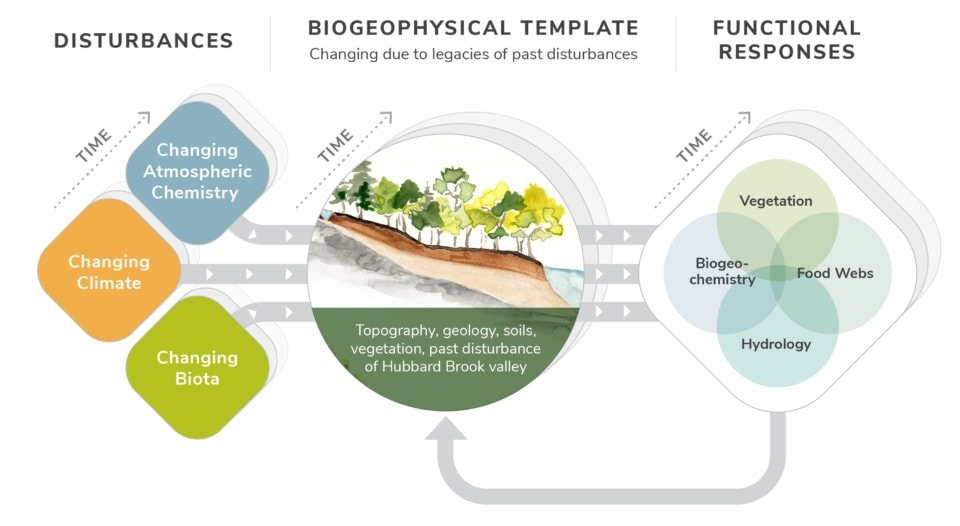 Our overall conceptual model focuses on three key drivers of change in the Hubbard Brook ecosystem: changing atmospheric chemistry, changing climate, and changing biota.
Our overall conceptual model focuses on three key drivers of change in the Hubbard Brook ecosystem: changing atmospheric chemistry, changing climate, and changing biota.
Our overall conceptual model illustrates that these drivers of change cause perturbations in the interacting ecosystem processes of biogeochemistry, hydrology, vegetation dynamics, and food webs, and that the responses may vary across the landscape because of the characteristics of the geophysical and historical template. Understanding the variation imposed by this template is an important fourth, cross-cutting, theme of HBES research.
Changing atmospheric chemistry. We are investigating how the forest and streams respond to recent declines in air pollution brought about by federal restrictions on emissions, and how the legacies of past pollutant deposition continue to affect ecosystem function. Specific projects include addition of calcium to an entire watershed to replace the calcium stripped from the soil by decades of acid rain, studies of the controls on retention and loss of nitrogen from forested watersheds, and experimental manipulation of soil nutrient availability to ascertain whether air pollution has changed the response of trees to mineral nutrients.
Changing Climate. Our ongoing studies of climate change focus on changes in winter such as reduced snowpack and soil freezing, ice storms, and lengthening of the winter-to-spring transition period which is critical to functioning of plants and soil microbes. We are manipulating forest plots to study the effects of soil warming, reduced snowpack, and drought. In a recent experiment we created an artificial ice storm on nine forest plots to better understand the response of the forest to the damage that such storms can create. We are also studying the impacts of changing climate on the populations of forest songbirds and their chief food supply, leaf-eating caterpillars.
Changing Biota. This theme includes research on forest regrowth after harvest as well as introduction of invasive species, and movement of species from lower elevations into the forested uplands on the Hubbard Brook Valley. We are tracking the long-term forest and stream responses to several whole-watershed forest harvest experiments performed in the 1960s, 70s and 80s. We are also studying the impacts of several invasive forest insects and diseases such as the beech bark disease and the emerald ash borer. In the streams, we are researching the changes in stream chemistry and biology due to declining acid deposition, as well as the population dynamics of salamanders, which are the top predators in the fishless headwater streams.
Biogeophysical template. We can learn a great deal about the functioning of the forest ecosystem by understanding how it varies across the range of topography present in the Hubbard Brook Valley. We have developed models to predict the locations of different soil types based on watershed topography, and are in the process of extending those models to broader areas. The type and extent of topography, geology, soil development, and past disturbance affects the biogeochemistry, vegetation, hydrology, and food webs at Hubbard Brook.
